Port of Fishguard, Wales
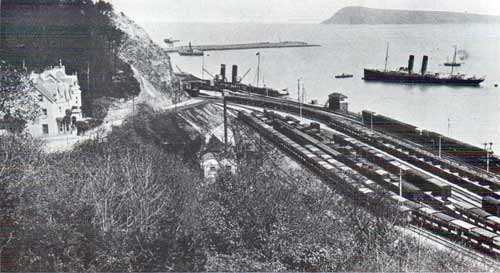
View of Fishguard Harbour circa 1913. Ward, Lock & Company Limited, London. GGA Image ID # 1437c3547f
Fishguard is situated on the southwest coast of Wales, and is the nearest British port to New York used by Atlantic liners. It affords the quickest means of reaching London, and is also a convenient port for the Continent. In addition, many parts of England and Wales are within easy access of Fishguard.
Fishguard Harbour - Information for Passengers (1913)
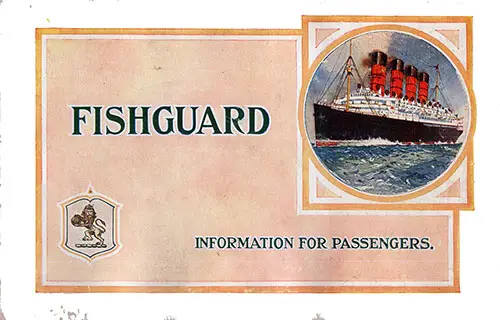
Front Cover, Fishguard Information For Passengers Brochure, Published by the Cunard Line 1913. GGA Image ID # 143857c0e2
Information for Passengers
Fishguard is situated on the south-west coast of Wales, and is the nearest British port to New York used by Atlantic liners. It affords the quickest means of reaching London, and is also a convenient port for the Continent.
In addition, many parts of England and Wales are within easy access of Fishguard; the Metropolis is 262 miles away and this distance is covered in under five hours.
The Approach to the New Port
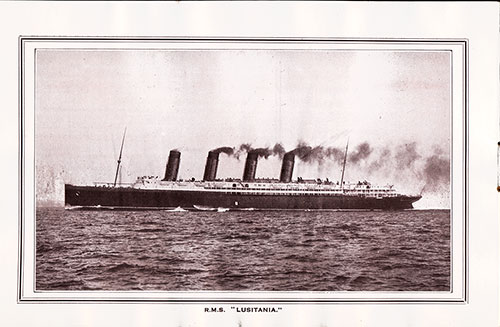
Cunard Line RMS Lusitania (1906). GGA Image ID # 143a2275be
The approach to Fishguard is easily discernible to the passenger. The bold headland of Strumble Head is rounded and this is some seven miles or so from Fishguard.
Then Dinas Head comes into view; and, stretching from the land between, is the long straight breakwater close to which the Cunard steamers anchor.
In Connection with the landing of passengers at Fishguard, a bell will be rung five minutes before the tender is ready to receive passengers. Passengers will, therefore, find it more comfortable and convenient not to wait about in the companionways and entrances.
Seats Reserved on the Train
Tickets for seats in the special train from Fishguard to London will be furnished to Saloon passengers holding railway coupons. Passengers who do not hold coupons can purchase same at Purser's Office before leaving the steamer.
All seats are numbered and reserved on the special train, and passengers should obtain seat tickets at Purser's Office as early as possible during the trip.
An Assistant Purser attends in the Second Cabin dining saloon at the time stated on the notice board, to issue railroad tickets and deal with all matters relating to the landing of passengers at Fishguard.
An Assistant Purser also attends for the same purpose in the Third Class dining saloon at the hour posted.
Railway Tickets
Single tickets and outward halves of return tickets between Fishguard and London are available for three months if purchased in America, or if issued in exchange for vouchers obtained in America. In other circumstances they are available for ten days.
Passengers are permitted to break the journey at any station on the route, provided the journey be completed within the periods named above. Return tickets are available for six months.
Restaurant Cars
On board the trains passengers will find ample provision for their comfort. The seating accommodation is on the most generous scale, and passengers can dine or lunch on the restaurant cars or be served with light refreshments if required.
How to Fnd Your Seat
Passengers will have no difficulty in finding their seats in the trains. Each carriage bears a large card outside showing the numbers of the seats in that carriage, and in one of the compartments of that carriage the passenger will find the numbered seat corresponding to the number on the card received from the Purser.
Thus all confusion is obviated, and the dispatch secured has won the highest opinions from experienced travelers who have used the route, and who are well acquainted with railway traveling on both sides of the Atlantic.
Telegrams and Cables
Facilities are provided on the landing quay to enable passengers to write and dispatch telegrams and cables.
Baggage Arrangements
The baggage of London-bound passengers is ready labeled, "London, via Fishguard," the lettering being white on a purple ground, the bold lettering and the distinctive coloring precluding the possibility of confusion.
As soon as the liner drops her anchor, the waiting takes the mails, another the baggage, which is conveniently disposed on the steamer for speedy removal to the tender, while a third is used for passengers.
The latter has ample saloon accommodation, so that the short journey of a few minutes' duration from ship to shore is made under the most comfortable conditions.

The Cunard RMS Mauretania approaching Fishguard Harbour. GGA Image ID # 143a3709ec
Customs' Examination
The passengers' tender is usually the last to leave the ship, and when the passenger walks ashore, he finds his baggage awaiting him in that section of the Customs' platform indicated by the initial letter of his name.
It is, therefore, essential for passengers to make sure that "initial" labels are put on their baggage, and, as an additional safeguard, it is desirable that all trunks, bags, etc., should also have a tag-label with the full name, and if possible, the address of the passenger.
Customs' inspectors proceed with their work of examination, and when this is performed, the baggage is at once transferred by porters to the train.
Passengers are relieved of all trouble in connection with their baggage by the porters, who will land it, unpack for Customs' examination, repack, and label it to destination station, free of charge.
Baggage Warehoused or Forwarded
Baggage can be warehoused at a small charge, if desired, or it will be sent by passenger train to the destination station (if on the G. W. R. system) free (if within weight allowed) and warehoused there. Arrangements can also be made for its delivery at destination at a moderate charge.
Arrival in London
Paddington is reached after a pleasant and interesting journey under five hours after leaving Fishguard, and passengers will find that excellent arrangements have been made to deal with the baggage.
The heavy pieces are carried in special vans, and on arrival at Paddington are landed on the platform at the front part of the train and again sorted out in alphabetical order.
Vehicles of every description are drawn up alongside the platform at Paddington, which is situated in the west-end of London, and is within easy access of all parts of the Metropolis.
Fishguard to London
The route from Fishguard to London, passing through the industrial centres in South Wales and the charming scenes of the Thames valley, is full of interest.
The speed at which the run is covered is the most potent tribute to the excellence of the Great Western's iron road and their rolling stock. Only one stop is made, and this of a very short duration, at Cardiff.
The waters of the Bristol Channel are skirted for a portion of the journey, and the more populous industrial centres of South Wales will be of peculiar interest, particularly to the business man.
The estuary of the Severn is negotiated by the Severn tunnel, which is nearly 4.5 miles long, and which is justly regarded as one of the world's principal engineering triumphs.
Thames Valley
Shortly after the Severn is passed the train enters the Thames valley, where charming vistas of "Father Thames" are obtained. Here are primitive ferries, with typical old-fashioned English inns adjacent, rural homesteads, hanging woods, and quaint weather-worn churches, surrounded by their hallowed areas where sleep the rude forefathers of the hamlet.
In short, the traveller enjoys a panorama of varied beauty, upon which the best English artists have exercised their genius for centuries past.
Fishguard of Today
Between the Fishguard of today and that of even a decade ago there is a great difference. A bay which boasted but of a departing or rather departed fishing industry, and was visited by only a few coastwise traders and fishing craft seeking shelter, has been converted into a splendid harbour, a harbour in which great natural advantages have been ably supplemented by the works which the Great Western Railway Company have constructed.
Fishguard Bay is protected on the east, south, and west by headlands and hills 300 or 400 feet high, and to the north by a substantial breakwater 2,000 feet in length. The bay is six miles across.
The Breakwater
The breakwater affords shelter from the north and north-easterly winds and seas, and extends seawards for a distance of over 2,000 feet. It is of the rubble type, with a width on the sea floor of 300 feet, a height from the sea bed of 90 feet, and a top width below the apron of 60 feet.
In the centre of the breakwater above the water line is a concrete core, which is built out as the breakwater advances, and has been found most efficacious.
The Quays
On the shore side of the breakwater, and near where it connects with the land, a quay has been constructed. This is the Ocean Quay at which the mails are disembarked and dispatched by special mail train to London.
The construction of this railway, which also runs alongside the quay at which passengers and their luggage are landed, may be classed among the great engineering feats of the century.
Originally the cliffs rose sheer from the water as they do now from the back of the station, and it was necessary to prepare a terrace for the quay and railway.
Blasting Operations
Blasting operations were resorted to, as much as 113,000 tons of rock being removed at a single operation. The spoil thus obtained was used in the construction of the breakwater, and also as filling for the quay, which is practically built upon a platform, obtained by dumping spoil from the blasting operations until a wall rising above the water level was secured.
Fishguard to Ireland
In this way a broad foundation of rock was made for the quay and also for the railway station, with its up-to-date equipment for both passengers and goods. At the quay by the railway station the splendid fleet of turbine steamers running between Fishguard and Rosslare (Ireland) are berthed, and here are the most modern appliances for the speedy transfer from ship to train, or vice versa, of goods and baggage.
Other Photographs from the 1913 Fishguard Brochure
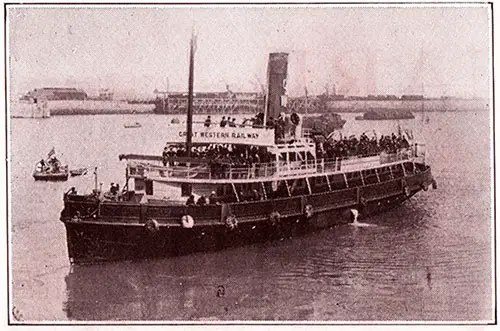
Passenger Tender Transports Passengers between the Steamships and Fishguard. GGA Image ID # 143b079a0c
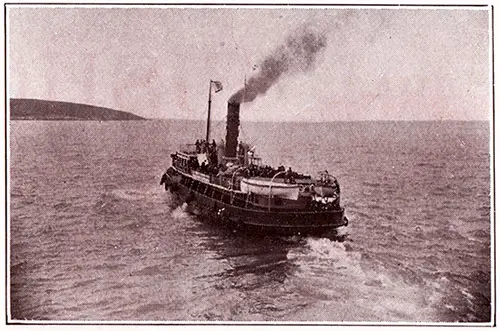
Baggage Tender Transports Passengers between the Steamships and Fishguard. GGA Image ID # 143b0f5bda
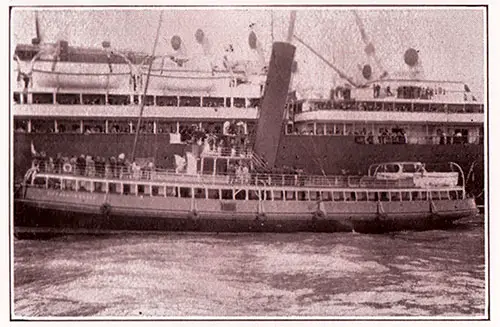
Passenger Tender Pulling Up Alongside an Ocean Liner Anchored in Fishguard Harbor. GGA Image ID # 143b5a2a08
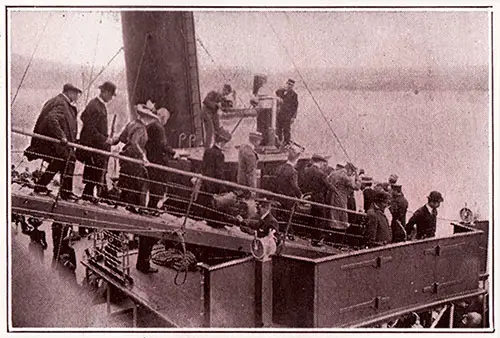
Passengers Disembarking on to Tender. GGA Image ID # 143b7342ba
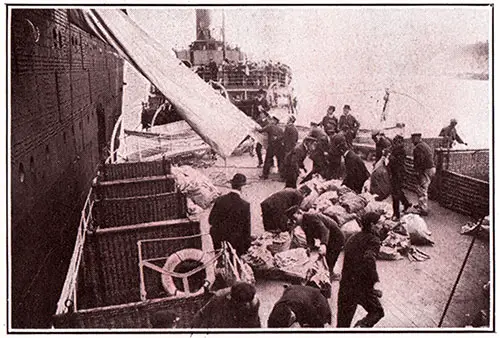
On Board the Mail Tender at Fishguard. GGA Image ID # 143b770d81
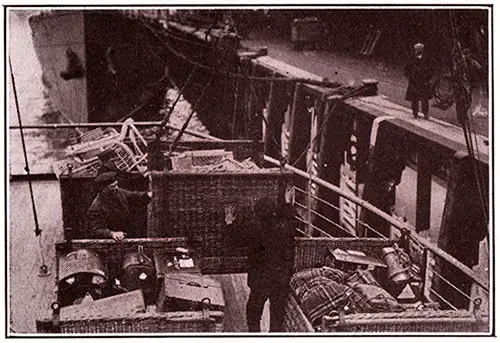
Landing Passengers Luggage at the Quayside, Fishguard. GGA Image ID # 143ba79800
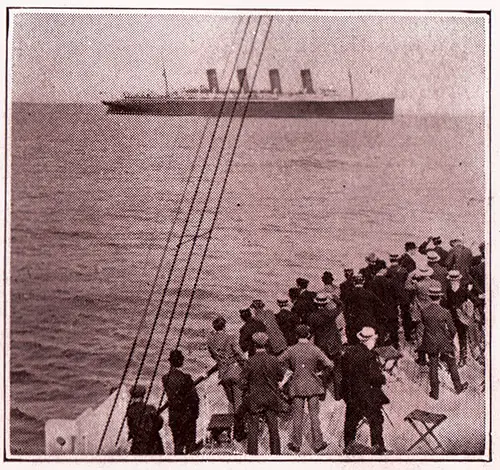
Mauretania Passengers Coming Ashore. GGA Image ID # 143bcf0872
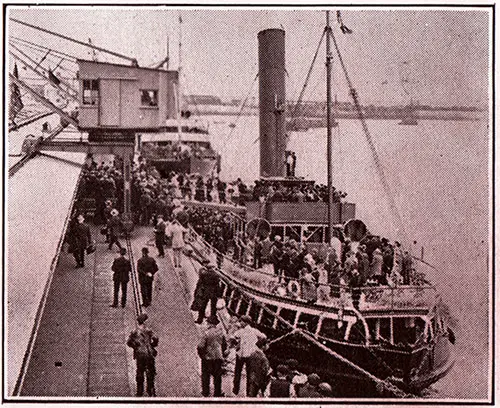
Passengers Tender At Fishguard Quayside. GGA Image ID # 143c41359e
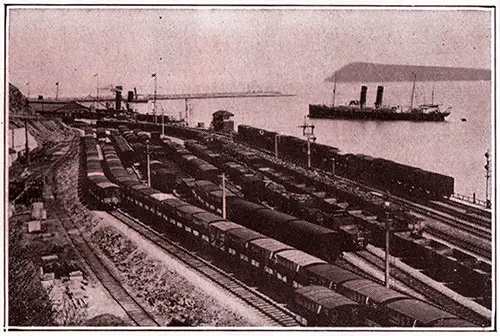
Rail Yard and Sidings At Fishguard. GGA Image ID # 143c6261d7
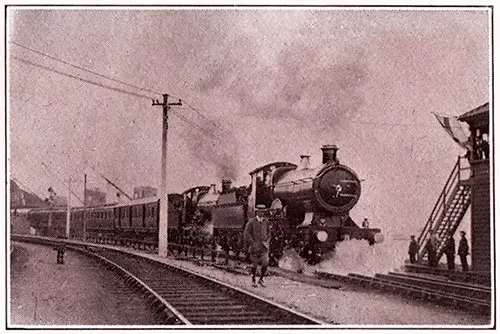
Passengers Depart on Train at Fishguard for the Short Trip to London. GGA Image ID # 143cadf7d3
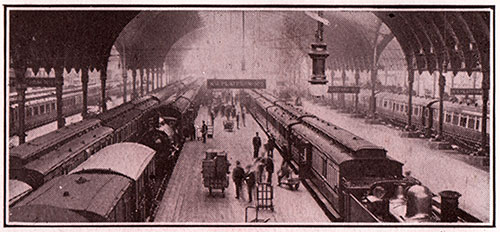
Paddington Station Today (1913). GGA Image ID # 143caf9cb4
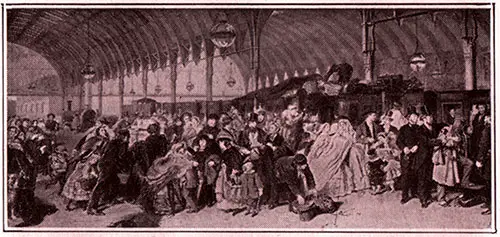
Paddington Station in Prunel's Time (circa 1850s). GGA Image ID # 143ce3a5f4
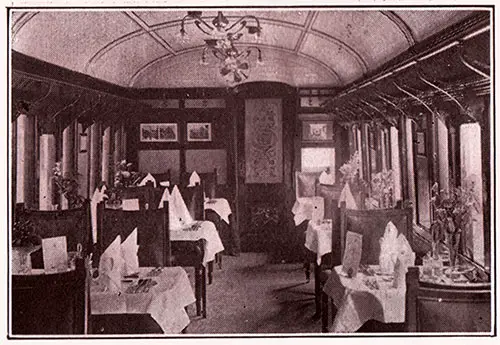
Interior View of Restaurant Car. GGA Image ID # 143d20501a
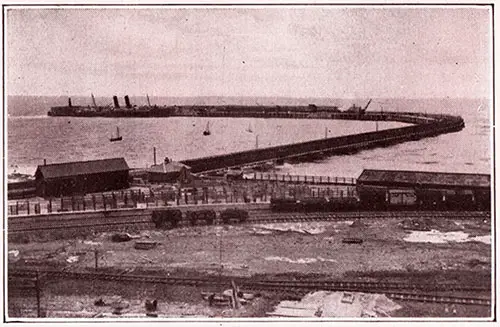
Rosslare Harbour. GGA Image ID # 143d5ef749
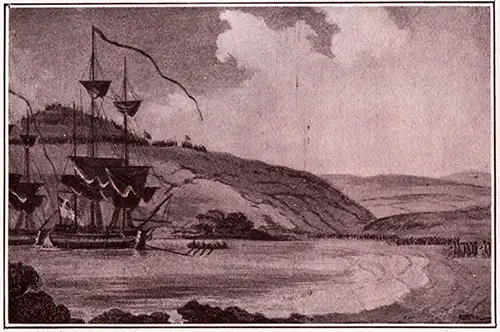
Landing of Troups from the French Firgates in Fishguard Bay. GGA Image ID # 143d6f0233
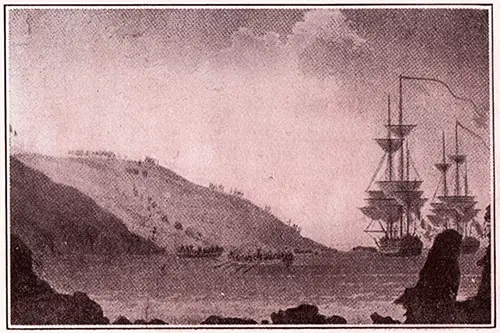
The French Camp at Fishguard. GGA Image ID # 143d8779b6
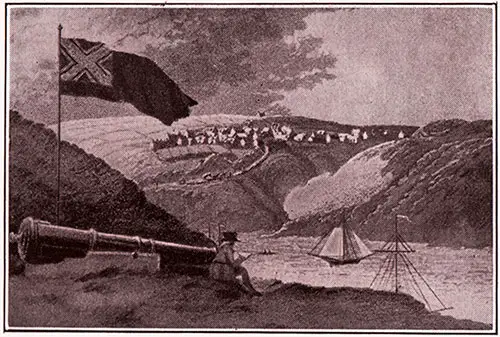
Fishguard Harbour in 1797 (from the old print in the Cardiff Library). GGA Image ID # 143dd4f5cd
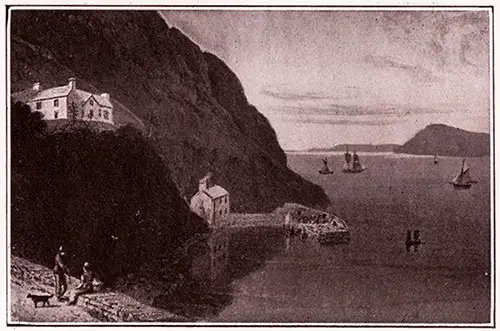
Fishguard a Hundred Years Ago (circa 1813) - (from a print of the period). GGA Image ID # 143dd7b66a
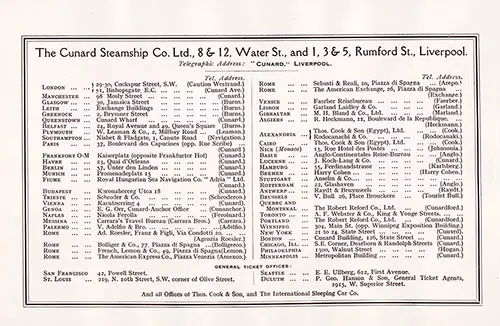
Offices and Agencies of the Cunard Line - 1913. GGA Image ID # 143e059adb
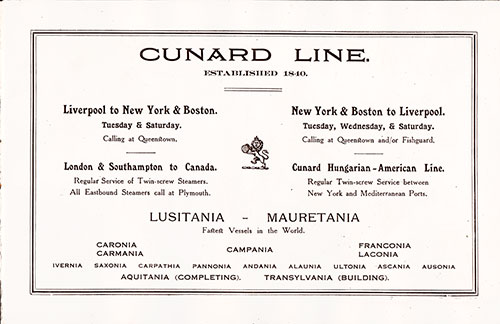
Cunard Line Services - 1913. GGA Image ID # 143e3a8711
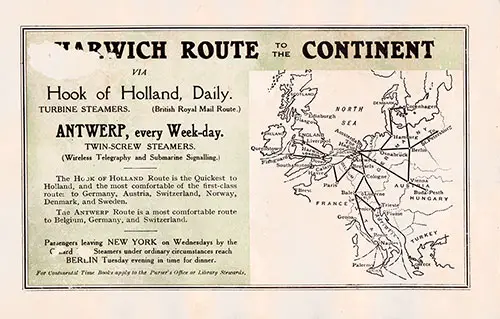
Harwich Route to the Continent via Hook of Holland. GGA Image ID # 143eff1050
The Hook of Holland Route is the Quickest to Holland, and the most comfortable of the first-class route to Germany, Austria, Switzerland, Norway, Denmark, and Sweden. The Antwerp Route is a comfortable route to Belgium, Germany, and Switzerland. Passengers leaving New York on Wednesdays by the Cunard Fast Steamers under ordinary circumstances reach Berlin Tuesday evening in time for dinner.
Great Western Railway of England - Arrangements at Fishguard (1913)

The inauguration of Fishguard as a Port of Call has brought New York 5 hours nearer to London, and in many instances by landing at Fishguard Passengers save nearly a whole day. GGA Image ID # 1438109b65
Fishguard Bay is protected on the East, South and West by headlands and hills 300 or 400 feet high, and to the North by a substantial breakwater 2,900 feet in length. The bay is 3 1/2 miles across.
Commodious steam tenders meet all Liners on arrival at Fishguard and convey Passengers to the landing quay
THE HARBOUR STATION
Fishguard Harbour Station is on the quay, and on landing Passengers only have a few paces to walk to the trains. Refreshment and waiting room accommodation is provided, whilst on a commanding position above the quays, and overlooking the bay, the Great Western Railway Company have under their own management the Fishguard Bay Hotel, where Passengers desirous of breaking the journey;at Fishguard and spending a day-or two in enjoying the attractions of the neighbourhood will find every comfort.
A Cable and Telegraph Office is situated at the Station for transmitting messages to all parts of the world.
BAGGAGE.
Passengers are relieved of all trouble in connection with their baggage by the Great Western Railway Staff, who will land it, unpack for the British Customs examination, repack, and label to destination station.
Baggage can be warehoused at a small charge, if desired, or will be sent by Passenger Train to destination station free (if within weight allowed) and warehoused there.
The Company will also, if required, arrange for its delivery at destination.
Baggage in the following quantities may be taken by every Ocean Passenger without extra charge :
- 1st Class Passenger :- 204 lbs.
- 3rd Class Passenger :- 120 lbs.
Any excess being charged at the ordinary Excess Luggage rate.
Heavy luggage can be left in charge of the Harbour Officials, to be forwarded as Freight, at Cheaper rates.
SPECIAL EXPRESS TRAINS TO ALL PARTS
Special Express Trains equipped with Restaurant Cars are usually run from Fishguard as soon as the Passengers are landed from the Ocean Steamers, These Trains run to London (Paddington Station) stopping at Cardiff to make connections for the West, North, South, and Midlands of England.
The time occupied by boat specials from Fishguard to Cardiff is 2 hours 20 minutes, and the journey throughout from Fishguard to London completed under 5 hours.
If the number of Passengers landing from an Ocean Steamer on any occasion does not warrant the running of a Special Train, through carriages to London will be provided on one of the regular Express Trains.
TO THE CONTINENT
Passengers for Paris, and the Continent generally, by landing at Fishguard reach their destination practically a day earlier than by any other route.
TO IRELAND

Paddington Station circa 1913. GGA Image ID # 1438247f11
Passengers for Ireland landing at Fishguard can proceed from there by the Great Western Railway Turbine Steamers every week-day after the arrival of the Boat Expresses from Paddington, due at 2.15 a.m. and 2.15 p.m., to Rosslare; on Tuesdays, Thursdays and Saturdays at 11.25 p.m. to Cork, and on Mondays, Wednesdays and Fridays at 1.45 p m. to Waterford, from which ports convenient fast Trains run into the interior of the country.
FARES FOR OCEAN PASSENGERS.
The following fares are in operation for Ocean Passengers landing at Fishguard
| Fishguard To | Single Journey | |||||
|---|---|---|---|---|---|---|
| English Currency | American Currency | |||||
| First Class | Third Class | First Class | Third Class | |||
| s. | d. | s. | d. | USD | USD | |
| London (Paddington) | 34 | 0 | 19 | 0 | $ 8.30 | $ 4.64 |
| Bath | 27 | 6 | 14 | 4 | $ 6.71 | $ 3.50 |
| Birmingham | 29 | 0 | 14 | 11 | $ 7.08 | $ 3.64 |
| Bristol | 25 | 9 | 13 | 4 | $ 6.29 | $ 3.26 |
| Cardiff | 18 | 9 | 9 | 10 | $ 4.58 | $ 2.40 |
| Cork (direct) | 15 | 0 | 10 | 0 | $ 3.66 | $ 2.44 |
| Dublin via Rosslare (Kingsbridge) and Kilkennv | 34 | 0 | 18 | 0‡ | $ 8.30 | $ 4.40 ‡ |
| Dublin via Rosa-(Harcourt Street) - tare and (Westland Row) ) Wexford | 27 | 0 | 15 | 5‡ | $ 6.59 | $ 3.77 ‡ |
| Killarney (via Rosslare) | 33 | 3 | 18 | 6‡ | $ 8.12 | $ 4.52 ‡ |
| Oxford | 35 | 0 | 18 | 0 | $ 8.54 | $ 4.40 |
| Paris (via Dover) | 99 | 8 | 59 | 8† | $ 24.32 | $ 14.56 † |
| Paris (via Folkestone) | 93 | 0 | 54 | 8† | $ 22.70 | $ 13.34 † |
| Stratford | 30 | 0 | 15 | 6 1/2 | $ 7.32 | $ 3.80 |
| Waterford (via Rosslare) | 14 | 0 | 9 | 0 | $ 3.42 | $ 2.20 |
‡ Third Class Rail and Saloon on Boat Tickets are also issued at 5s. 6d. ($1.35) over the Third Class fare.
† Third Class to London, Second London to Paris.
AVAILABILITY OF TICKETS.
Single Tickets and Outward Halves of Return Tickets between Fishguard and London are available for three months if purchased in America, or on board Ocean Liners from America. In other circumstances they are available for ten days.
Passengers are permitted co breakthe journey at any station on the route, provided the journey be completed within the periods named above. Return Tickets are available for six months.
In addition to the Direct Service from Fishguard to London, tickets may be obtained from the G.W.R. General Agent, 501, Fifth Avenue, New York, or at Fishguard Station for several alternative routes, which are available for three months and admit of break of journey at the principal places of interest, finishing at London (Paddington Station).
It will be seen from the particulars given below that these Tickets offer Ocean Passengers the selection of several comprehensive Tours through the most delightful parts of historic England and Wales, at a cost slightly in excess of the through direct fares :—
| From Fishguard to London by | Fares | |||
|---|---|---|---|---|
| English Currency | American Currency | |||
| First Class | Third Class | First Class | Third Class | |
| ₤ s. d. | ₤ s. d. | USD | USD | |
| TOUR No. 1 :- Via Carmarthen, Aberystwyth, Bar-mouth, Dolgelley, Bala, Llangollen, Ru a bon Che s ter , Shrewsbury, Birmingham, Stratford on-Avon, Warwick, Leamington, Oxford and Windsor | 3 1 0 | 1 12 0 | $14.89 | $7.81 |
| TOUR No. 2 :- Via Carmarthen, Aberystwyth, Bar-mouth, Dolgelley, Bala, Llangollen, Ruabon, Chester, Shrewsbury, Bridgnorth, Worcester, Stratford-on-Avon, Warwick, Leamington, Oxford and Windsor | 3 1 0 | 1 12 0 | $14.89 | $7.81 |
| TOUR No. 3 :- Via Carmarthen, Aberystwyth, Bar mouth, Dolgelley, Bala, Llangollen, Ruabon, Chester, Shre wsbury, Hereford Abergavenny, Bristol, Bath and Windsor | 3 9 0 | 1 15 6 | $16.84 | $8.67 |
| TOUR No. 4 :- Via Neyland, Pembroke Dock, Tenby, Carmarthen, Cardiff, Newport, Chepstow, Ti n t ern, Monmouth, Ross, Hereford, Shrewsbury, Chester, Stratford-on-Avon, Warwick, Leamington, Oxford and Windsor. Passengers pay small charge for Ferry service, Neyland to Pembroke Dock | 3 4 0 | 1 13 0 | $15.62 | $8.00 |
| TOUR No. 15 :- Via Chepstow, Tintern, Monmouth, Ross, Gloucester, Cheltenham, Stratford-on-Avon, Warwick, Leamington, Oxford and Windsor | 2 8 0 | 1 5 0 | $11.72 | $8.10 |
RAIL JOURNEY INCLUDED IN STEAMSHIP PASSAGE TICKETS.
PASSENGERS LANDING AT Fishguard) from Cunard Liners whose destination is London or Paris can obtain their Railway Coupons or Tickets before embarking from any of the Cunard Company's principal offices in America.
Passengers for other places are handed vouchers which have to be exchanged at the Booking Office for tickets without further payment. By the Booth Line orders are in all cases supplied by the pursers to be exchanged at the Booking Office on the landing stage for a railway ticket.
ACCOMMODATION IN LONDON.
If accommodation be required at the Great Western Royal Hotel, Paddington Station, London, the Company's Officials will upon notification telegraph, free of charge, for reservation to be made. Private omnibuses can be ordered in the same way.
G.W.R. TIME TABLES
Great Western Railway Time Tables, Pamphlets, etc., are on board the Liners for reference.
Fishguard Express Route - America to London and The Coninent (1912)
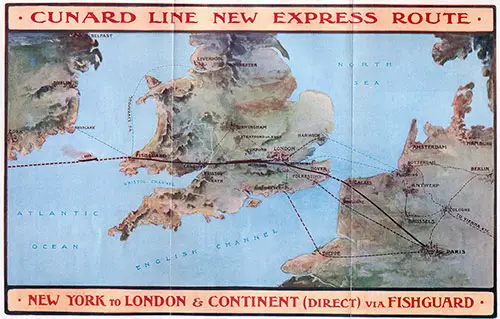
Map of Express Route, America to London and the Continent via Fishguard, which is Recognized as the Most Expeditious Route. GGA Image ID # 143f54b48f
With the view of enabling passengers to reach London on Monday afternoon and Paris the same evening or following morning, the " Lusitania" and " Mauretania " have been scheduled to leave the New York Pier at 1 a.m. on Wednesdays (except On 17th and 24th December, as per sailing list) and proceed direct to Fishguard without calling at Queenstown.
The steamers will thus be due at Fishguard on Monday morning. A Cold Buffet Supper will be served to Passengers between 9 p.m. and midnight on Tuesdays. All other New York steamers will call at both Queenstown and Fishguard, the "Campania" leaving New York at 1 a.m. Wednesday (except on the 31st December, as per sailing list), and "Carmania" and "Caronia" at 10 a.m. on sailing day.
Steamers from Boston call at Queenstown all the year round and also at Fishguard during May, June and July. The Great Western Railway provide special trains from Fishguard for London (Paddington), the railway journey occupying about 4 3/4 hours. Special trains will also be provided for the Channel Ports when sufficient inducement offers. FISHGUARD is the nearest British port to New York and Boston, and this route is therefore the most direct to London.
Queenstown was a British port (which is why it was so named) and Ireland (Ulster, Munster, Leinster and Connaught) was part of the UK. In the 1920s Munster, Leinster and Connaught became independent and Ulster remained within the UK. Queenstown was then renamed Cobh by the new republic. But Queenstown was the nearest British port to New York in 1910. I thought Queenstown (Cork) was the nearest British port to New York in 1910 - because that was the Titantic's last port of call in 1912. --
Contributed by M. Rich, Reigate, Surrey, UK
Editor's Note: Queenstown was originally called Cove by the British and named Queens-town in 1849 in honor of Queen Victoria, who disembarked there on her first visit to Ireland. In 1922, after the creation of the Irish Free State, it reclaimed its former name – but with an Irish spelling (Cobh).
The New Port of Call for Ocean Liners (1910)
The new port of call for Ocean Liners is one of the finest natural harbours in the world, and affords excellent facilities for the rapid transfer of passengers and baggage from Ocean Liners.
A considerable saving of time is effected by Passengers landing at Fishguard. Special trains formed of Vestibuled Coaches and Restaurant Cars run to London after the arrival of Liners, the journey of 262 miles occupying about 4 3/4 hours, whilst the direct connections to Paris, s-c., frequently save a day over any other route.
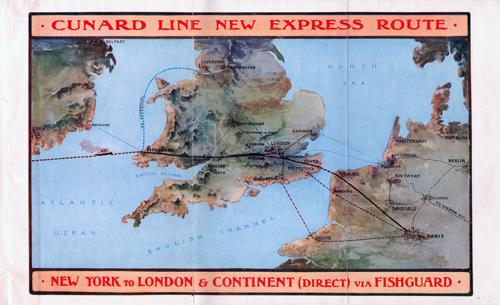
Map of the Cunard Line New Express Route: New York to London & Continent (Direct) via Fishguard circa 1910. GGA Image ID # 1437d6efc8
Express Route - New York to London via Fishguard (1910)
THE attention of passengers is. specially drawn to the facilities provided by the Cunard Line for their American patrons in reaching London and the Continent by travelling via Fishguard on the South Wales Coast, which is now recognised as the most expeditious route.
The " Lusitania " and " Mauretania" will leave the New York Pier at 9 a.m. and proceed direct to Fishguard, without calling at Queenstown. All other New York Steamers will call at both Queenstown and Fishguard.
The Great Western Railway provide special trains from Fishguard for London (Paddington), the railway journey occupying about 4 hours.
FISHGUARD is the nearest British port to New York, and this route is therefore the most direct to London.
Bibliography
Great Western Railway of England, Handbook for Travellers from Over-seas, April, 1913 Brochure
Fishguard: Information for Passengers, Cunard Steamship Company, Limited, Liverpool, Undated circa 1913, 20 Pages.
Cunard Line Royal & United States Mail Steamers 2nd Cabin Passenger List brochure, 23 November 1912, page 3. In 1910
Cunard Line Saloon Passenger List, RMS Campania, From Liverpool, Saturday, September 24th, 1910, For New York, via Queenstown (Cobh).
The Port of Fishguard (1910)
The new port of call at Fishguard has produced some new conditions in the English transportation field. The following is some valuable Information relative to disembarking at this place: The inauguration of Fishguard as a port of call has brought New York 5 hours nearer to London.
Fishguard Bay is protected on the east, south, and west by headlands and hills 300 or 400 feet high, and to the north by a substantial breakwater 2,000 feet in length. The bay is 6 miles across. Commodious steam tenders meet all liners on arrival at Fishguard and convey passengers to the landing stage.
Fishguard Harbor station is on the quay, and upon landing, passengers only have a few yards to walk to join the trains In waiting. Ample refreshment and waiting room accommodation are provided, while on a commanding position above the quays. Overlooking the bay, the G. W. R. Co., have under their management the Fishguard Bay Hotel (late "Hotel, Wyncllffe"), where passengers desire to break the journey Fishguard spend a day or two in enjoying the attractions of the neighborhood will find every comfort.
Passengers are relieved of all trouble related to their baggage by the G. W. R. Staff, who will land it, unpack for Customs examination, repack, and register and label it to the destination, free of charge. Baggage can be warehoused at a small charge if desired, or it will be sent by passenger train to the destination station free (if within weight allowed) and warehoused there.
The company will also, if required, arrange for its delivery at the destination at a reasonable charge. Heavy luggage can be left in charge of the dock officials, to be forwarded by goods train, at goods train rates. A cable and telegraph office is situated at the landing quay for transmitting messages to all parts of the world.
Special express trains will be run from Fishguard as soon as the passengers are landed from the ocean steamers. Passengers for Paris and the Continent generally, by landing at Fishguard, reach their destination practically a day earlier than by any other route. The special boat trains will be equipped with a restaurant car, and if a night journey is made, with a sleeping car.
Suppose the number of passengers landing from an ocean steamer on any occasion does not warrant the running of a special train throughout. In that case, the regular schedule of express trains will be available, through carriage accommodation to London being provided.
